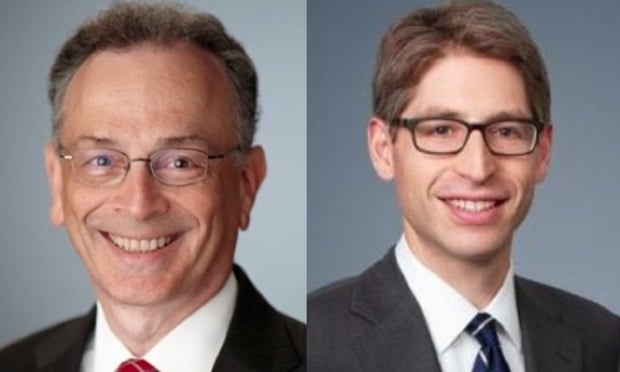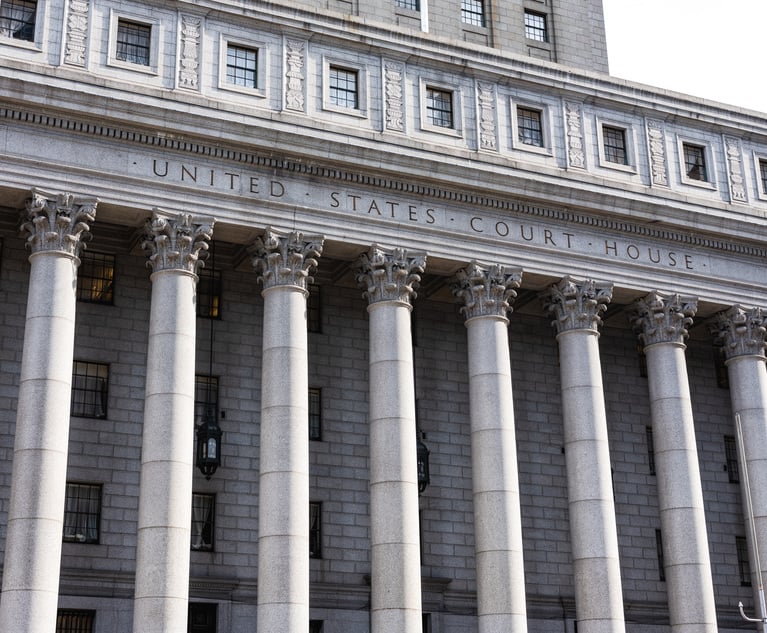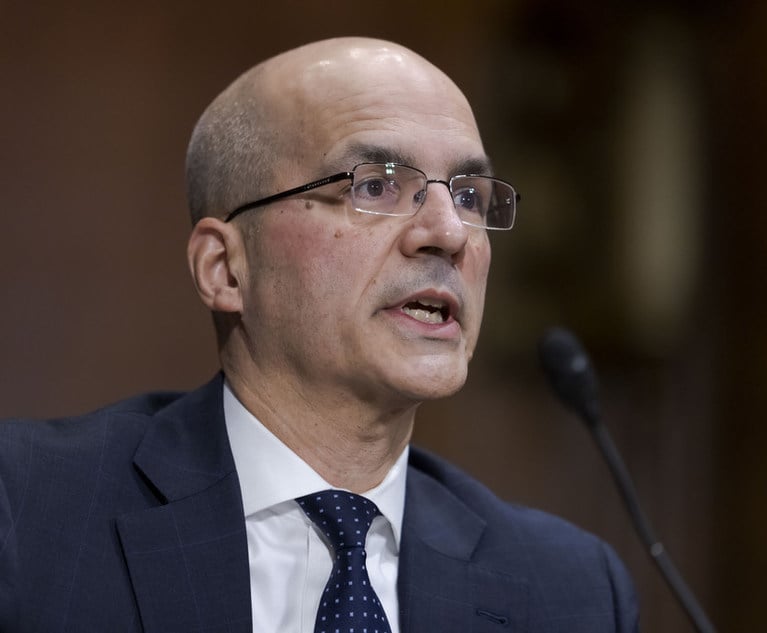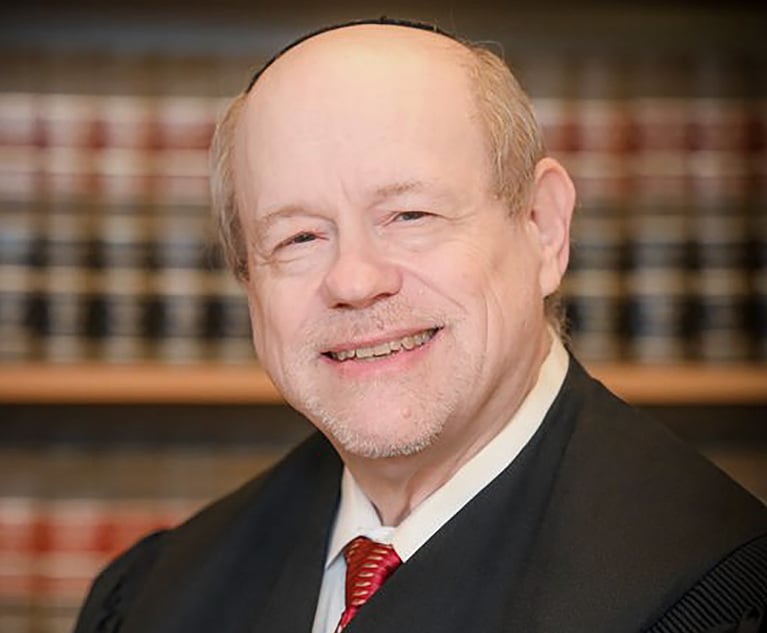The Limits of Withholding Expert-Generated Materials
Southern District Magistrate Judge Gabriel W. Gorenstein rejected the plaintiff's claim that a memorandum that his expert had prepared in advance of the expert's deposition—on his own accord and absent any instruction from counsel—qualified for protection as a draft report or an expert-attorney communication. In this edition of their Southern District Civil Practice Roundup, Edward M. Spiro and Christopher B. Harwood discuss this case, Hernandez v. The Office of the Commissioner of Baseball.
June 15, 2020 at 12:46 PM
8 minute read
 Edward M. Spiro and Christopher B. Harwood
Edward M. Spiro and Christopher B. HarwoodIn 2010, Rule 26 of the Federal Rules of Civil Procedure was amended to impose new restrictions on (and significantly narrow) the scope of expert discovery, including by extending work product protection to draft expert reports and communications between an expert and the attorneys for the party that engaged the expert. Not surprisingly, litigants have since tried to withhold a wide variety of expert-generated materials on the ground that they constitute draft reports or expert-attorney communications. Courts, however, have pushed back on these efforts when litigants have stretched the bounds of what qualifies as a draft report or an expert-attorney communication too far, a recent example being Hernandez v. The Office of the Commissioner of Baseball, 2020 WL 2529576 (S.D.N.Y. May 19, 2020). In that case, Southern District Magistrate Judge Gabriel W. Gorenstein rejected the plaintiff's claim that a memorandum that his expert had prepared in advance of the expert's deposition—on his own accord and absent any instruction from counsel—qualified for protection as a draft report or an expert-attorney communication.
'Hernandez'
Angel Hernandez ( the plaintiff), an umpire employed by Major League Baseball (MLB), has sued the Commissioner of Baseball and a related entity (collectively, defendants), claiming that MLB discriminated against him by not assigning him to umpire the World Series and by not promoting him to be a crew chief. The plaintiff alleges that "the Crew Chief Promotion Process relies overwhelmingly on subjective criteria" and thus "gives Major League Baseball nearly limitless authority to promote to the crew chief position whichever umpire it wants, without adequate consideration for objective data or objective criteria that would guide [MLB's] decision-making process."
In expert discovery, the defendants deposed the plaintiff's expert, Gregory W. Baxter, on March 5, During Mr. Baxter's deposition, counsel asked him if he had reviewed any documents to prepare for the deposition. Mr. Baxter responded that he had reviewed "[a] memo I had written to myself but never included in the expert report." Mr. Baxter further described the document as: "A memo on the methodology for identifying comments as positive, negative or platitude and the method for identifying whether the author's comments in the year-end reviews were supported or unsupported by the Umpire Evaluation Reports or UERs."
Mr. Baxter testified that he prepared the memorandum on Feb. 1—many weeks after he submitted his expert report—and that he prepared it "[b]ecause I expected to be deposed about my methodology." Mr. Baxter further explained that he prepared the memorandum "[t]o help the jury and to be clear in my deposition." When asked if counsel had requested that he prepare the memorandum, Mr. Baxter responded that counsel had not. In a subsequent affidavit, Mr. Baxter stated that on Feb. 7, he sent a copy of the document to plaintiff's counsel with the subject line "Proposed Supplement to Baxter's Expert Report." Mr. Baxter also asserted in the affidavit that the document had the heading "February 6 2020 Supplement to Dr. Baxter's Expert Report Methodology for Comparing Minority Year End Performance Review (YE) to Umpire Evaluation Reports (UER)," thus suggesting that the document was created in connection with a potential new expert report.
Following Mr. Baxter's deposition, defendants sought to compel production of the memorandum. The plaintiff resisted, claiming that the memorandum is protected under Rule 26(b)(4) both as a draft report and a communication between the plaintiff's expert and his counsel.
The 2010 Amendments to Rule 26
Before Rule 26 was amended in 2010, the pre-amendment rule protected little when it came to draft expert reports and attorney-expert communications, resulting in wide-ranging discovery. As amended, Rule 26 now "protect[s] drafts of any [expert] reports … regardless of the form in which the draft is recorded," as well as "communications between the party's attorney and any [expert] required to provide a report." As Gorenstein observed, the 2010 amendments were intended to narrow the scope of expert discovery, and "to allow attorneys and experts to communicate and prepare reports without fear that an opposing party might be able to peer into that process and learn the attorney's own analysis of the case." See Hernandez, 2020 WL 2529576, at *3 (citing Fed. R. Civ. P. 26, Advisory Committee Notes). Gorenstein determined, however, that Mr. Baxter's memorandum did not qualify for withholding under the 2010 amendments.
The Draft Report Argument
Gorenstein rejected the plaintiff's first argument for withholding the memorandum—that it constitutes a draft report—because, during Mr. Baxter's deposition, he had conceded that the document was "[a] memo I had written to myself … [b]ecause I expected to be deposed about my methodology." Gorenstein noted that Mr. Baxter "never claimed [that the memorandum] was a draft report at his deposition," and he therefore rejected the suggestion in Mr. Baxter's subsequent affidavit that it was. Citing multiple Second Circuit decisions, Gorenstein observed that "it is well settled that a party may not create an issue of fact by submitting an affidavit … that … contradicts the affiant's previous deposition testimony."
Gorenstein went on to find that even if Mr. Baxter intended the memorandum to be a draft of a new report, plaintiff still would not be entitled to withhold it, because "the court made no provision in its scheduling order for the submission of any supplemental report." Gorenstein noted that "Rule 26(b)(4)(B) protects only drafts of any reports or disclosure required under Rule 26(a)(2)." He therefore concluded that the memorandum could not possibly qualify for protection as a draft report, because "[n]o supplemental report was 'required' in this case" and Mr. Baxter confirmed during his deposition that the memorandum "was not prepared at the request of counsel." Gorenstein observed that his holding "is entirely in keeping with the purpose of the core work product rule, which is to protect an attorney's mental impressions, conclusions, opinions, or legal theories from exposure—not the expert's."
The Communications-to-Attorney Argument
Gorenstein also rejected plaintiff's argument that the memorandum is protected as a "communication[] between the [plaintiff's] attorney and [his expert]." Gorenstein found the lack of "evidence that the report was created at the request of the [plaintiff's] attorney or that it was [created] for the purpose of communicating with [plaintiff's] attorney" fatal to this argument. That Mr. Baxter "ultimately transmitted the document to [plaintiff's] attorney" was of no relevance (Gorenstein reasoned), because the plaintiff did "not me[e]t his burden of showing that when the document was prepared[,] its purpose was to communicate with an attorney." To the contrary, Mr. Baxter "unequivocally testified that the memorandum was prepared for himself, in anticipation of his deposition, as a way to summarize his methodology."
Having found that Mr. Baxter created "the memorandum … as notes to [himself] regarding [his] own report, not as an effort to communicate with an attorney," Gorenstein concluded that the document could not qualify for protection under Rule 26. That conclusion held, Judge Gorenstein noted, even if "the memorandum was created around the time of, or even in anticipation of, a conversation between [Mr.] Baxter and [plaintiff's] counsel," or "[Mr.] Baxter eventually sent the document to [plaintiff's counsel]," "because at its creation the document was never intended to be, and was not itself, a communication to any attorney." At bottom, the memorandum reflected Mr. Baxter's notes to himself, and "[a]n expert's notes to himself do not qualify for protection under Fed. R. Civ. P. 26(b)(4)."
Accordingly, Gorenstein ordered plaintiff to disclose the memorandum to defendants, and authorized defendants to re-depose Mr. Baxter about the memorandum and matters related to it.
Conclusion
Although the 2010 amendments to Rule 26 have given counsel the ability to withhold many expert-generated materials, limits still exist as to what counsel may withhold. As Hernandez demonstrates, courts will police such withholdings to ensure that the withheld materials in fact qualify as draft reports or expert-attorney communications. Counsel should remind their experts to exercise care in preparing notes or memoranda for the experts' internal use.
Edward M. Spiro and Christopher B. Harwood are principals of Morvillo Abramowitz Grand Iason & Anello. Spiro is the co-author of "Civil Practice in the Southern District of New York," 2d Ed. (Thomson Reuters 2020), and Harwood is the former Co-Chief of the Civil Frauds Unit at the U.S. Attorney's Office for the Southern District of New York.
This content has been archived. It is available through our partners, LexisNexis® and Bloomberg Law.
To view this content, please continue to their sites.
Not a Lexis Subscriber?
Subscribe Now
Not a Bloomberg Law Subscriber?
Subscribe Now
NOT FOR REPRINT
© 2025 ALM Global, LLC, All Rights Reserved. Request academic re-use from www.copyright.com. All other uses, submit a request to [email protected]. For more information visit Asset & Logo Licensing.
You Might Like
View All
Decision of the Day: Qui Tam Relators Do Not Plausibly Claim Firm Avoided Tax Obligations Through Visa Applications, Circuit Finds

'Serious Legal Errors'?: Rival League May Appeal Following Dismissal of Soccer Antitrust Case
6 minute read
Decision of the Day: Judge Sanctions Attorney for 'Frivolously' Claiming All Nine Personal Injury Categories in Motor Vehicle Case

Law Firms Mentioned
Trending Stories
- 1Big Law's Middle East Bet: Will It Pay Off?
- 2'Translate Across Disciplines': Paul Hastings’ New Tech Transactions Leader
- 3Milbank’s Revenue and Profits Surge Following Demand Increases Across the Board
- 4Fourth Quarter Growth in Demand and Worked Rates Coincided with Countercyclical Dip, New Report Indicates
- 5Public Notices/Calendars
Who Got The Work
J. Brugh Lower of Gibbons has entered an appearance for industrial equipment supplier Devco Corporation in a pending trademark infringement lawsuit. The suit, accusing the defendant of selling knock-off Graco products, was filed Dec. 18 in New Jersey District Court by Rivkin Radler on behalf of Graco Inc. and Graco Minnesota. The case, assigned to U.S. District Judge Zahid N. Quraishi, is 3:24-cv-11294, Graco Inc. et al v. Devco Corporation.
Who Got The Work
Rebecca Maller-Stein and Kent A. Yalowitz of Arnold & Porter Kaye Scholer have entered their appearances for Hanaco Venture Capital and its executives, Lior Prosor and David Frankel, in a pending securities lawsuit. The action, filed on Dec. 24 in New York Southern District Court by Zell, Aron & Co. on behalf of Goldeneye Advisors, accuses the defendants of negligently and fraudulently managing the plaintiff's $1 million investment. The case, assigned to U.S. District Judge Vernon S. Broderick, is 1:24-cv-09918, Goldeneye Advisors, LLC v. Hanaco Venture Capital, Ltd. et al.
Who Got The Work
Attorneys from A&O Shearman has stepped in as defense counsel for Toronto-Dominion Bank and other defendants in a pending securities class action. The suit, filed Dec. 11 in New York Southern District Court by Bleichmar Fonti & Auld, accuses the defendants of concealing the bank's 'pervasive' deficiencies in regards to its compliance with the Bank Secrecy Act and the quality of its anti-money laundering controls. The case, assigned to U.S. District Judge Arun Subramanian, is 1:24-cv-09445, Gonzalez v. The Toronto-Dominion Bank et al.
Who Got The Work
Crown Castle International, a Pennsylvania company providing shared communications infrastructure, has turned to Luke D. Wolf of Gordon Rees Scully Mansukhani to fend off a pending breach-of-contract lawsuit. The court action, filed Nov. 25 in Michigan Eastern District Court by Hooper Hathaway PC on behalf of The Town Residences LLC, accuses Crown Castle of failing to transfer approximately $30,000 in utility payments from T-Mobile in breach of a roof-top lease and assignment agreement. The case, assigned to U.S. District Judge Susan K. Declercq, is 2:24-cv-13131, The Town Residences LLC v. T-Mobile US, Inc. et al.
Who Got The Work
Wilfred P. Coronato and Daniel M. Schwartz of McCarter & English have stepped in as defense counsel to Electrolux Home Products Inc. in a pending product liability lawsuit. The court action, filed Nov. 26 in New York Eastern District Court by Poulos Lopiccolo PC and Nagel Rice LLP on behalf of David Stern, alleges that the defendant's refrigerators’ drawers and shelving repeatedly break and fall apart within months after purchase. The case, assigned to U.S. District Judge Joan M. Azrack, is 2:24-cv-08204, Stern v. Electrolux Home Products, Inc.
Featured Firms
Law Offices of Gary Martin Hays & Associates, P.C.
(470) 294-1674
Law Offices of Mark E. Salomone
(857) 444-6468
Smith & Hassler
(713) 739-1250






